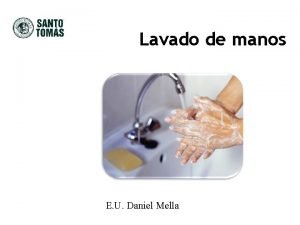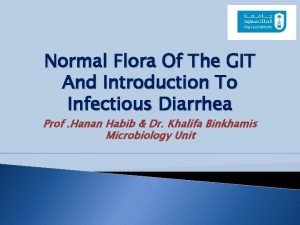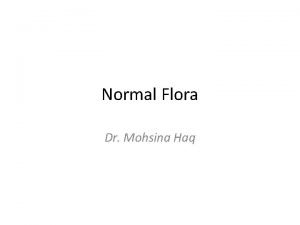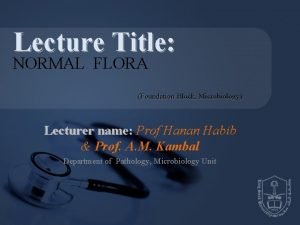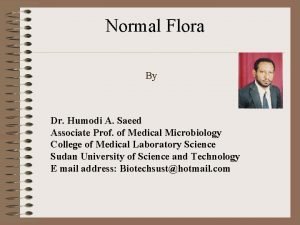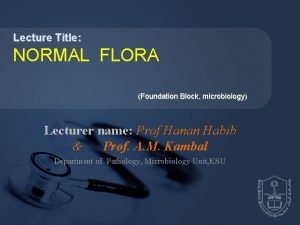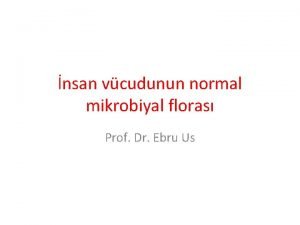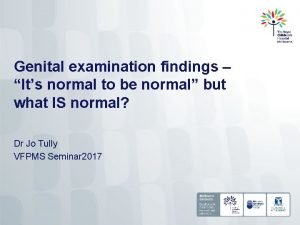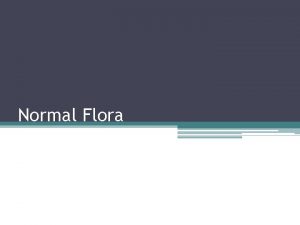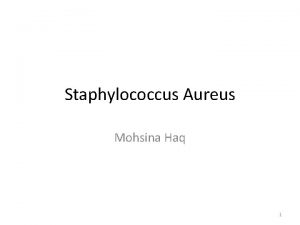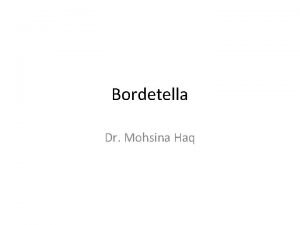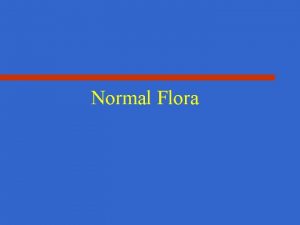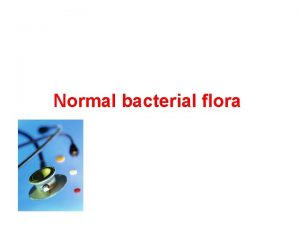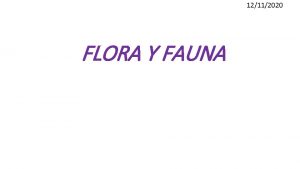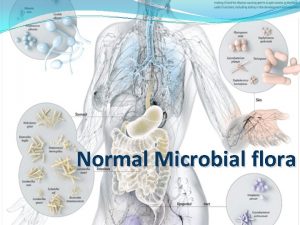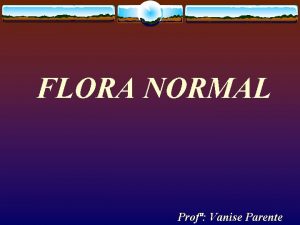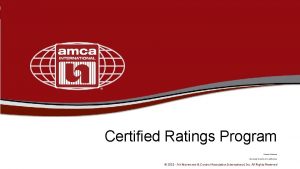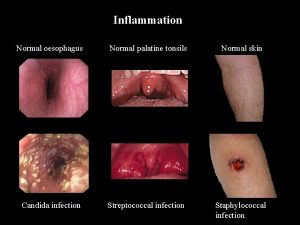Normal Flora Dr Mohsina Haq The term flora



























- Slides: 27

Normal Flora Dr. Mohsina Haq

• The term flora is used for collective bacteria and other microorganisms in an ecosystem such as the human host

• Also called as – Human microbiome – Human microbiota • It includes: – Bacteria – Fungi • It is acquired rapidly and shortly after birth and changes continuously through out our lives

Types of Microbiota • Indigenous microbiota – Establishes a permanent relationship with various parts of the body • Transient microbiota – More temporary and found only for limited periods

Present on • • • Skin External eyes and ears Upper respiratory tract Gastro intestinal tract Urogenital orifices (males and females)

Areas that are sterile • • Blood Cerebrospinal fluid Join fluids Internal organs • Sterile: devoid of living organisms, viruses and spores

• Mutualism • Mutualistic relationships provide reciprocal benefits for the two organisms involved • Commensalism • In commensalism, one species of organism lives harmlessly in or on the body of a larger specie • Parasitism • The symbiotic relationship benefits only the parasite • Symbiosis • Close and long term biological interaction between different biological organisms


Factors influencing Normal Flora • Local environment • p. H, temperature, nutrient level • Diet • Age • Young age, old age • Immune status • Immunocompetent, immunocompromised • Antibiotics

Humans as Habitats

Flora of Skin • Predominant organism • Staphylococcus epidermidis (non pathogenic on skin) • Location • Superficial layer(stratum corneum), hair follicles • It initiates a disease process when they are disseminated to other sites • Artificial heart valves • Prosthetic joints

• Yeast: Candida Albicans • non pathogenic in skin • If it enters blood streams it leads to infection • Can cause systemic infection

Other microorganisms present on skin • Staphylococcus epidermidis • Staphylococcus aureus • Alpha-hemolytic and non hemolytic streptococcus • Micrococcus species • Peptostreptococcus species • Diphtheroids • Acinetobacter species

Normal Flora of Respiratory Tract • Normally colonizes – Nose – Throat – mouth • Very rarely found in – bronchi – alveoli

• Nose: – Mostly aerobic bacteria • • Staphylococcus species (aureus) Streptococci (pmeumoniae, pyogenes) Diphtheroids (corynebacterium) Neisseria meningitidis

Normal Flora of Mouth • Mouth is also a site that are heavily colonized by bacteria • Teeth and gingiva carry a large number of anaerobic bacteria • Streptococcus mutans if present in plaque and leads to dental decay (carries) • Acid ferments to carbohydrates that attack enamel • Plaque is a film of bacterial cells anchored in the polysaccharide matrix that the organism secrets

Normal flora of oral cavity

Normal Flora of Respiratory System Flora of Pharynx and Trachea – They carry there own flora that includes α and β hemolytic streptococci – staphylococcus aureus, Neisseria and diphtheroids are also present – Some healthy individuals may carry Pneumocystis jirovecii (fungus) in there lungs

Normal flora of Gastrointestinal Tract • Harbors only transient organisms • p. H of the stomach provides an acidic environment • Some organisms that are acid-tolerant colonizes the mucosa • E. g. lactobacillus and streptococci • Commonest is H. pylori

• Ileum is lightly colonized, but population increases markedly in ileum • Streptococci, lactobacilli, Enterobacteriaceae and bacteroides , E. coli • Harmless protozoan (entamoeba coli) • Densely colonized is the large bowel

Frequency of occurrence and densities of the bacteria making up the GIT flora

Flora of the Urogenital Tract • Urethra is colonized lightly in both genders • Staph. epidermidis, strep. faecalis and diphtheroids • other organisims that are present • Lactobacillus aerophilus • Candida (fungal) causes thrush • Trichomonas vaginalis


Advantages and Disadvantages of Normal Flora • Skin bacteria • prevents invasion by producing fatty acids • Gut bacteria • • • Antibacterial activity (bacteriocins, colins) Helps in metabolism Helps in digestion Produces vitamin B and K Antigenic stimulation improves immune system • Urogenital flora • Lactobacillius maintains an acidic environment that discourages the growth of other bacteria

Disadvantages • The disadvantages of normal flora lie in the potential for spread into previously sterile parts of the body. This happens when • • Intestine is perforated Extraction of teeth Organism ascends into the urethra from perianal skin Unsterile environment during venipuncture • Over growth of bacteria occurs when • Local environment changes the p. H • Immune system becomes ineffective


 Alisher navoiy fikrlari
Alisher navoiy fikrlari Dr izhar ul haq
Dr izhar ul haq Flora residente y transitoria oms
Flora residente y transitoria oms Flora de la zona sur
Flora de la zona sur Git flora
Git flora Normal flora of oral cavity
Normal flora of oral cavity Definition of normal flora
Definition of normal flora Definition of normal flora
Definition of normal flora Normal flora of respiratory tract
Normal flora of respiratory tract Normal flora definition
Normal flora definition Git normal flora
Git normal flora Definition of normal flora
Definition of normal flora üst solunum yolu flora elemanları üredi
üst solunum yolu flora elemanları üredi It's normal to be normal
It's normal to be normal Loading response gait
Loading response gait Tri-planar circular motion at the hip or shoulder
Tri-planar circular motion at the hip or shoulder Prerequisites of gait
Prerequisites of gait Nth term rule
Nth term rule Long term memory vs short term memory
Long term memory vs short term memory Difference between long term and short term liabilities
Difference between long term and short term liabilities Term to term rule
Term to term rule Nth term of ap
Nth term of ap Long term liabilities
Long term liabilities Short medium and long term planning in education
Short medium and long term planning in education Good short term goals
Good short term goals Short term human resources examples
Short term human resources examples Minterms
Minterms In my understanding
In my understanding


